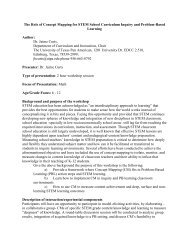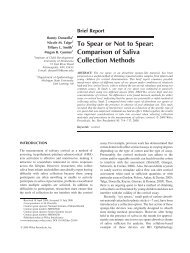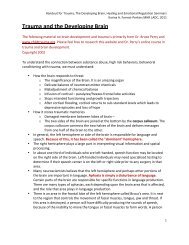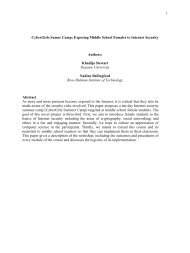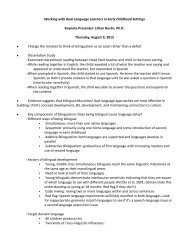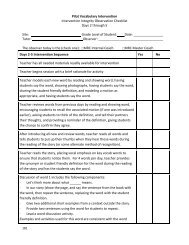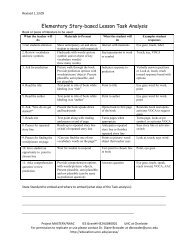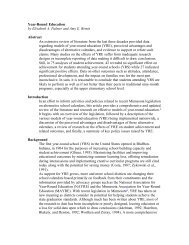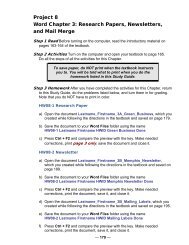Introduction to Positive Ways of Intervening with Challenging Behavior
Introduction to Positive Ways of Intervening with Challenging Behavior
Introduction to Positive Ways of Intervening with Challenging Behavior
You also want an ePaper? Increase the reach of your titles
YUMPU automatically turns print PDFs into web optimized ePapers that Google loves.
You also need <strong>to</strong> find a way <strong>to</strong> keep yourself emotionally calm and <strong>to</strong> protect yourself from being<br />
manipulated by the student when he or she begins <strong>to</strong> display these behaviors. Decide on several proactive<br />
interventions <strong>to</strong> use in teaching the student <strong>to</strong> change his or her behavior.<br />
It can also be helpful <strong>to</strong> hold a conference <strong>with</strong> the student and, if possible, <strong>with</strong> the student's parents. Let the<br />
student know what is and is not acceptable and how you will help him or her <strong>to</strong> learn <strong>to</strong> behave appropriately.<br />
Stick <strong>to</strong> and periodically evaluate your intervention. Keep in mind that it <strong>to</strong>ok the student a long time <strong>to</strong> learn<br />
these behaviors and it will likely take a long time <strong>to</strong> replace them <strong>with</strong> others. Do not let yourself fall in<strong>to</strong> old<br />
patterns <strong>of</strong> reacting angrily.<br />
Let the student know you care about him or her. Make it a point <strong>to</strong> give the student some brief friendly<br />
attention each day. Give the student the opportunity <strong>to</strong> talk about his or her feelings and provide reinforcement.<br />
Give the student special responsibilities and ensure that he or she knows what the expectations are by asking how<br />
the task will be completed. For example, if you ask the student <strong>to</strong> bring the roll call <strong>to</strong> the <strong>of</strong>fice ask, "How long<br />
do you think this should take you?", "Is it necessary <strong>to</strong> s<strong>to</strong>p anywhere along the way (i.e., bathroom, other<br />
classrooms)?" This helps define and organize the task for the student, promoting success. Finally, reinforce all<br />
appropriate and thoughtful behavior, all appropriate bids for attention, and all acceptable expressions <strong>of</strong> anger and<br />
frustration.<br />
It is important that the student learn that it is okay <strong>to</strong> feel frustrated and angry and that there are acceptable<br />
ways <strong>of</strong> expressing feelings. Furthermore, it is important <strong>to</strong> build the student's self-esteem by reinforcing him or<br />
her and encouraging the student <strong>to</strong> reinforce him or herself.<br />
What proactive interventions are effective in changing passive-aggressive behavior?<br />
<strong>Positive</strong> reinforcement is very important in improving the student's self-esteem and changing his or her selfperception.<br />
Modeling helps the student learn new behavior. Token economies can also be useful in motivating<br />
the student <strong>to</strong> change behavior. Cooperative learning gives student's the opportunity <strong>to</strong> learn from their peers.<br />
Self-moni<strong>to</strong>ring can help a student assume more responsibility for his or her behavior. (See tip sheets <strong>with</strong><br />
respective titles.)<br />
How do I avoid being drawn in<strong>to</strong> a conflict or get out <strong>of</strong> it once I recognize it?<br />
Remember, these tactics are only <strong>to</strong> help you avoid or get out <strong>of</strong> a conflict cycle. They alone will not ultimately<br />
change the student's behavior. In order <strong>to</strong> do this, it is imperative that you perform a functional assessment and<br />
implement a long-term, proactive intervention plan, including techniques such as those listed earlier.<br />
First, you must learn <strong>to</strong> not allow yourself <strong>to</strong> be manipulated emotionally. Once you have been emotionally<br />
drawn in by the passive-aggressive student, it is very difficult <strong>to</strong> regain composure. Use self-talk <strong>to</strong> tell yourself,<br />
"I know what the student is doing and why. It is not a personal attack against me, and I will remain calm while<br />
trying <strong>to</strong> help the student."<br />
When you recognize the student displaying annoying, attention-seeking behavior, remember that this stems<br />
from frustration. The student needs support. If a student is working on a math assignment, you might approach the<br />
student by saying, "Ripping up math papers is not acceptable, John. Let's get you another and I'll sit down <strong>with</strong><br />
you and we can work on it <strong>to</strong>gether." In this way, you are letting the student know that you do not accept his or<br />
her behavior but you are not nagging. You are also letting the student know that you care and want <strong>to</strong> help.<br />
If the cycle has not been s<strong>to</strong>pped at the frustration stage, you will have <strong>to</strong> deal <strong>with</strong> the next stage:<br />
defensiveness. At this point the teacher will need <strong>to</strong> set limits for the student. For example, if John refused <strong>to</strong><br />
cooperate in getting another math paper and accepting assistance by stating, "Leave me alone, I don't need your<br />
help," the teacher might state, "Your math work needs <strong>to</strong> be completed. You may do it <strong>with</strong> or <strong>with</strong>out me, but<br />
you need <strong>to</strong> get your math sheets, sit down, and work on them quietly. If you reach something you don't<br />
understand, you will raise your hand and ask me for help." In this case, you have defined the limits and left the<br />
decision up <strong>to</strong> the student as <strong>to</strong> whether he will or will not follow your instructions. You have also stepped out <strong>of</strong><br />
a conflict cycle by remaining calm.




